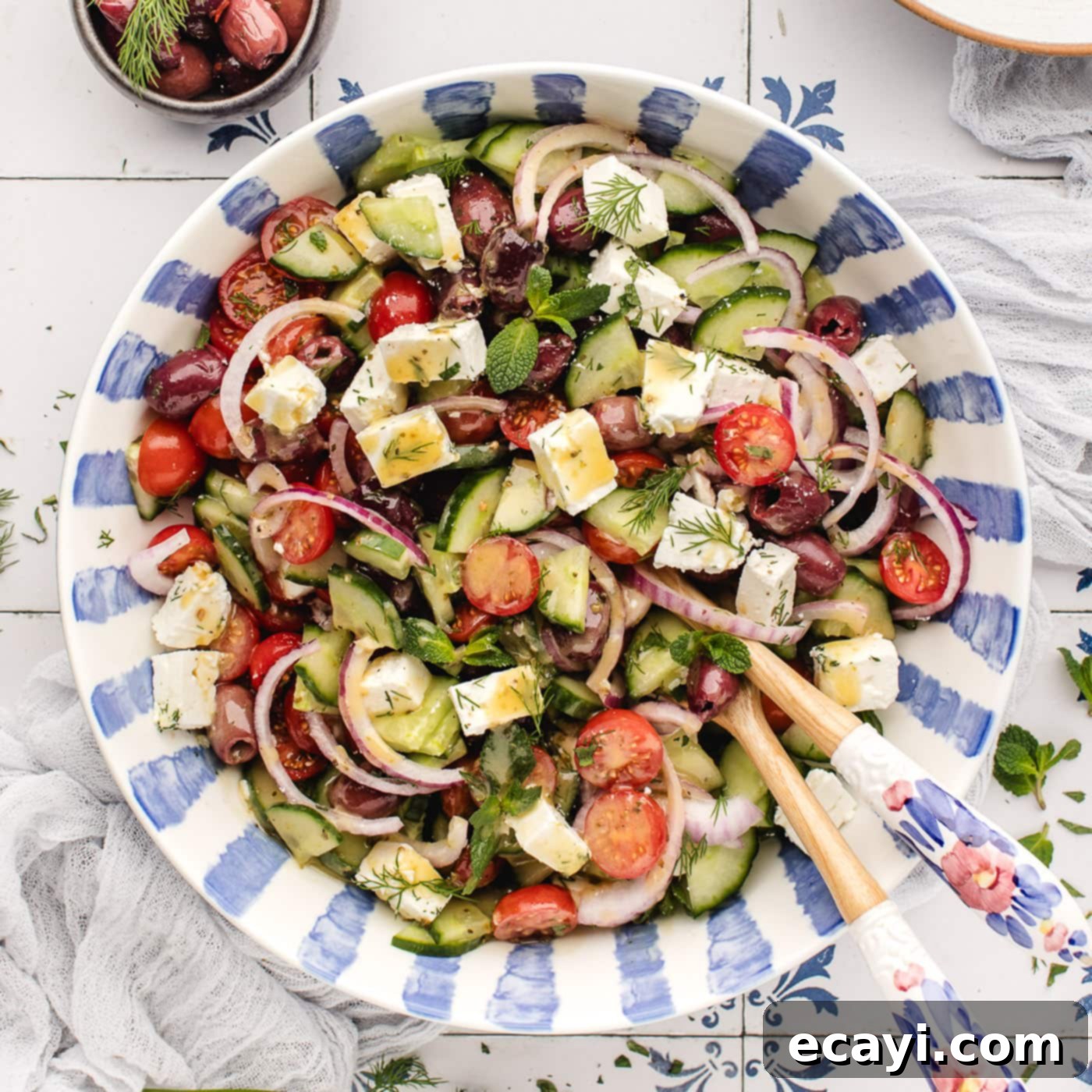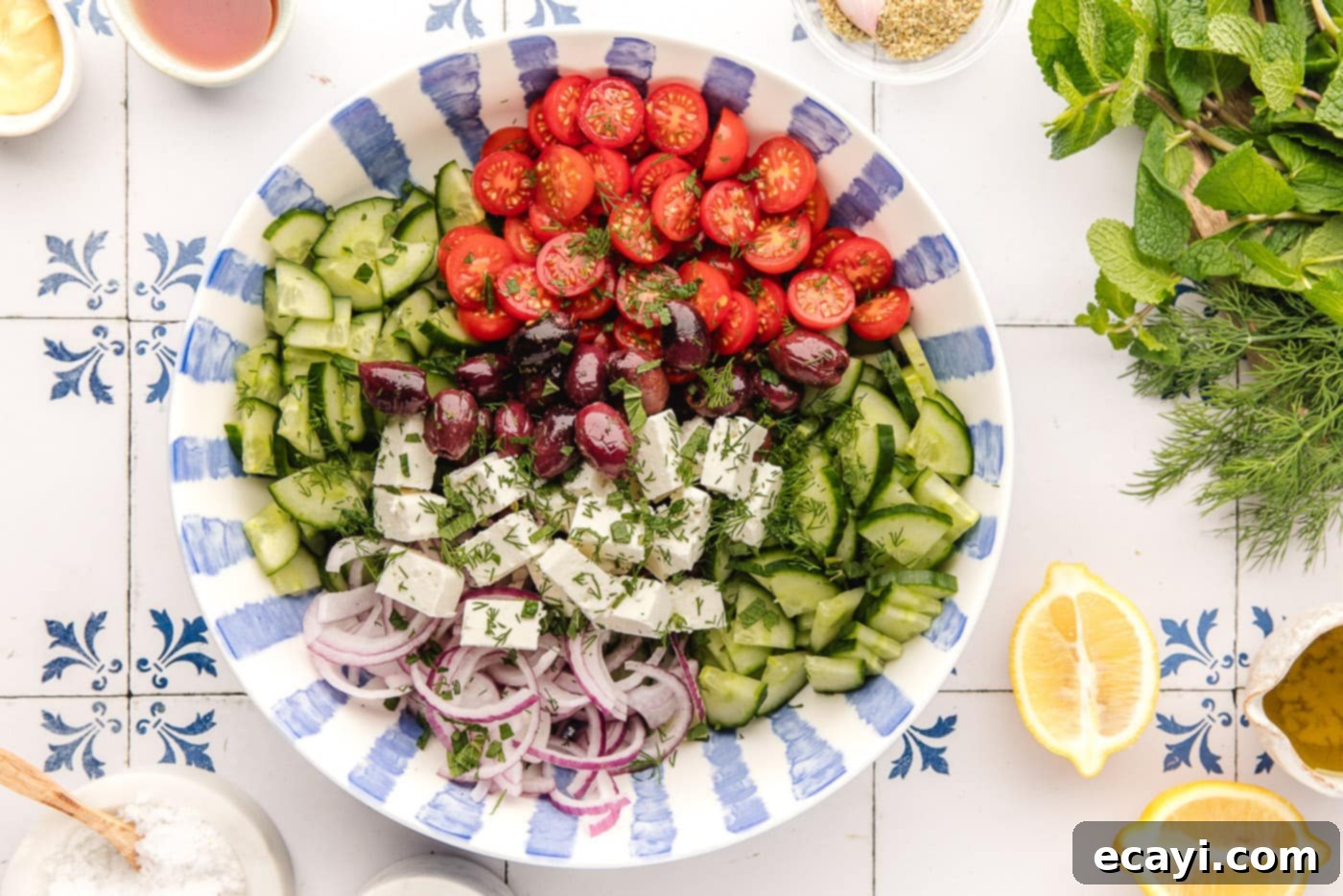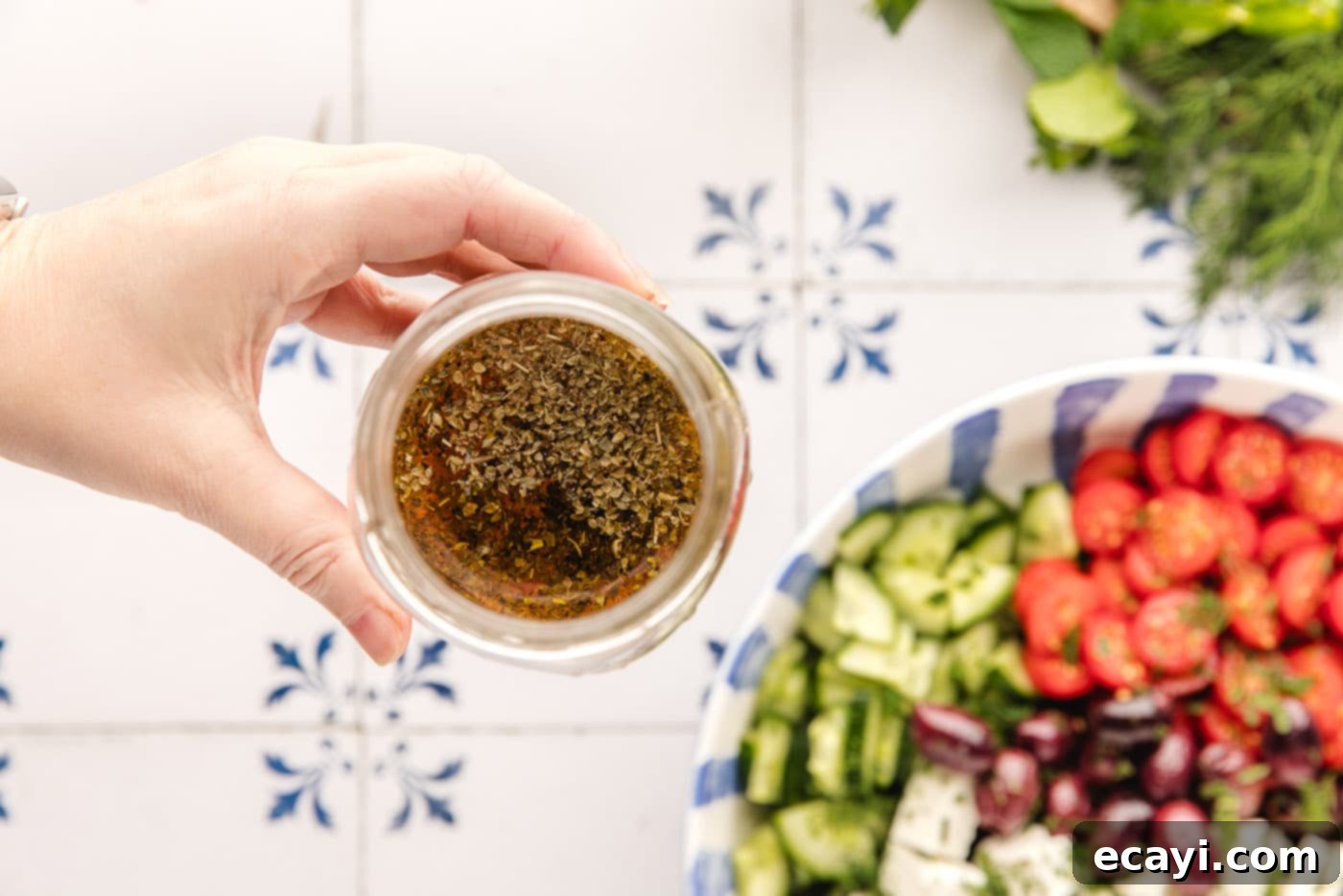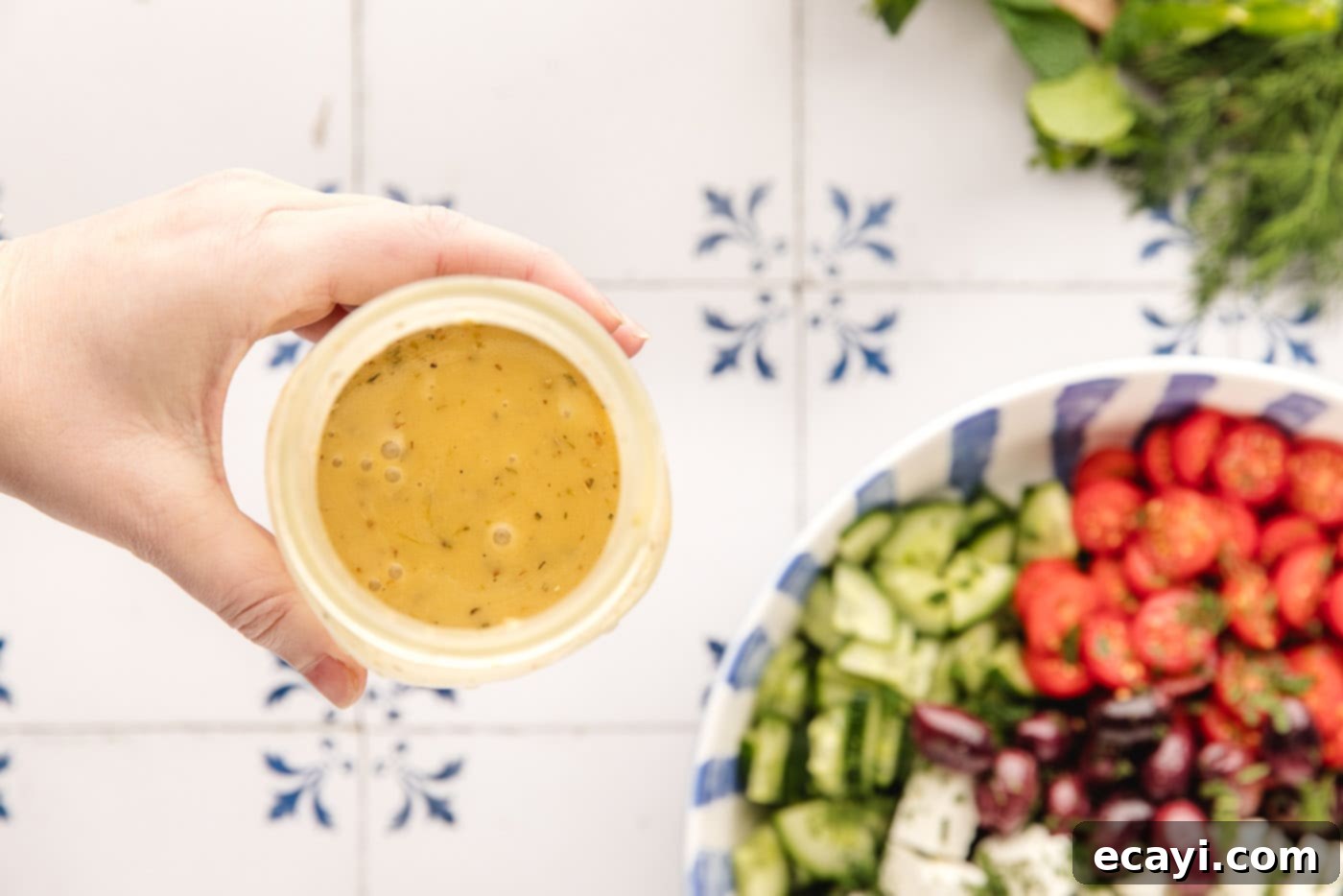Authentic Greek Salad Recipe: Fresh, Healthy & Ready in Minutes!
Transport your taste buds straight to the sun-drenched shores of the Mediterranean with this authentic Greek Salad recipe. Bursting with vibrant colors and refreshing flavors, this salad is not just a feast for the eyes but an incredibly easy dish to whip up in as little as 10 minutes. Featuring an array of crisp vegetables, salty feta, and briny olives, all generously coated in a zesty Greek vinaigrette, it’s a perfect addition to any summer party, backyard barbecue, or as a light, healthy meal on its own. Simply chop, drizzle, toss, and serve your way to a delicious culinary escape!

Why This Easy Greek Salad Recipe Works So Well
There’s a reason Greek salad (often referred to as Horiatiki in Greece) remains a beloved classic worldwide, and particularly throughout the summer months. This recipe isn’t just about combining ingredients; it’s about harmonizing simple, fresh produce to create an explosion of Mediterranean flavors that are both invigorating and deeply satisfying. It stands out as one of the easiest and freshest salads you can master, perfect for novice cooks and seasoned chefs alike.
The magic lies in its carefully selected components: crisp cucumber, ripe tomatoes, creamy feta cheese, briny Kalamata olives, thinly sliced red onion, and fresh aromatic herbs like dill and mint. Each ingredient plays a crucial role, contributing to a vibrant medley of textures and tastes. When these fresh elements are generously tossed in a zingy, homemade Greek vinaigrette, they create a rainbow of veggies that are not only visually appealing but deliver a punch of authentic Mediterranean goodness. It’s a dish that celebrates the bounty of nature, requiring minimal effort for maximum flavor, making it an ideal choice for quick weeknight dinners or impressive gatherings.
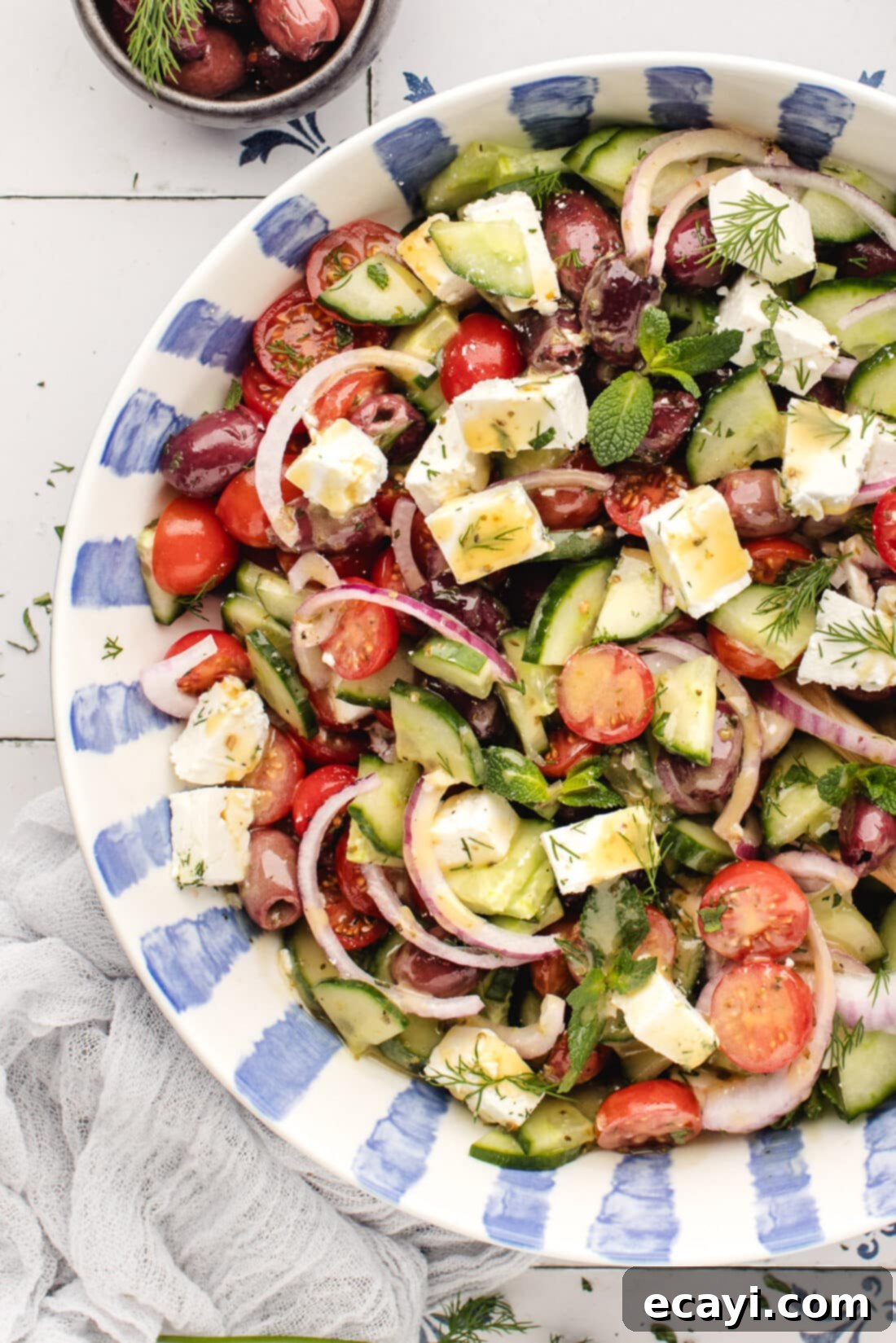
Essential Ingredients for Your Greek Salad
Crafting the perfect Greek salad starts with selecting the freshest, highest quality ingredients. While the full list of measurements and step-by-step instructions can be found in the printable recipe card at the end of this post, here’s a quick overview of what you’ll need to gather to bring this delicious salad to life. Each component contributes to the signature taste and texture that makes authentic Greek salad so irresistible.

Ingredient Spotlight & Smart Substitutions
Let’s dive deeper into the key components of our Greek salad and explore how you can optimize them for the best flavor and texture, along with clever substitution ideas to suit your preferences or what you have on hand.
CUCUMBER – For this Greek Salad, we highly recommend using an English cucumber. These varieties are known for having fewer watery seeds in their center compared to standard garden cucumbers, which means less moisture and more crispness in your finished salad. Their thin skin also means no need for peeling, saving you precious prep time. English cucumbers also tend to be sweeter and crunchier, contributing perfectly to the salad’s refreshing profile. Often, one large English cucumber is sufficient for a family-sized salad. If you can’t find an English cucumber, Persian cucumbers are a great alternative, or a regular cucumber can be used if you scoop out the watery seed core before chopping.
TOMATO – The choice of tomato can significantly impact your salad’s visual appeal and flavor. You have several excellent options: cherry tomatoes and grape tomatoes are fantastic for their sweetness, bite-sized convenience, and vibrant color when halved. If you prefer larger tomatoes, such as Roma, beefsteak, or even heirloom varieties, simply chop them into bite-sized pieces. Aim for ripe, firm tomatoes that offer a good balance of sweetness and acidity. The best tomatoes are often those in season, so select accordingly for the freshest taste.
FETA CHEESE – Feta is the quintessential ingredient that defines a Greek salad. For an authentic experience, look for feta cheese made from sheep’s or a combination of sheep’s and goat’s milk, typically imported from Greece. This type of feta offers a more complex, tangy, and briny flavor compared to cow’s milk feta. You can buy it in a block and cube it yourself for rustic appeal, or opt for pre-crumbled feta for convenience. The salty, tangy notes of feta perfectly complement the fresh vegetables and rich vinaigrette.
KALAMATA OLIVES – These dark, almond-shaped olives with their distinctive purplish hue and fruity, briny flavor are essential for an authentic Greek salad. Always opt for pitted Kalamata olives to make eating easier. While other black olives can be used in a pinch, none quite replicate the unique taste that Kalamatas bring to the dish.
RED ONION – A finely sliced red onion adds a pungent, sharp bite that contrasts beautifully with the other milder ingredients. For those who find raw red onion too strong, a quick trick is to soak the sliced onion in a bowl of ice water for 10-15 minutes before adding it to the salad. This helps to mellow its sharpness without losing its characteristic flavor and crispness.
FRESH HERBS (DILL & MINT) – Fresh herbs elevate this salad from good to extraordinary. Dill and mint provide bright, aromatic notes that are deeply characteristic of Mediterranean cuisine. Don’t skip them! Roughly chopped, they infuse the salad with an irresistible freshness. Feel free to adjust the quantities to your taste, adding more if you love their potent flavors.
DRESSING – Our dressing is a classic Greek salad vinaigrette, embodying the perfect balance of acidity and richness. We recommend preparing it by shaking all the dressing ingredients in a mason jar with a secure lid until fully combined and emulsified. This method creates a perfectly blended, zesty dressing that clings beautifully to the ingredients. If you’re planning on making this salad in advance, simply prepare the dressing and store it separately in the jar in the refrigerator, tossing it into the salad just before serving to prevent the vegetables from becoming soggy. For those leaning towards a creamier dressing, a homemade Tzatziki sauce would also taste delicious. Tzatziki, a refreshing Greek yogurt-based dip, combines Greek yogurt with fresh lemon, dill, and garlic, offering a cool and tangy alternative. You can find out how to make it in our tzatziki salad recipe.
OPTIONAL ADDITIONS & ENHANCEMENTS – This Greek salad is wonderfully versatile and can be customized with additional ingredients. Bell pepper (red, yellow, or orange for extra color and sweetness), capers (for an additional briny kick), and avocado (for creamy texture and healthy fats) are all fantastic additions. You might also consider adding chickpeas for extra protein and fiber, or even grilled chicken or shrimp to transform it into a more substantial main course.
How to Craft Your Perfect Greek Salad
These step-by-step photos and detailed instructions are here to help you visualize how to make this delightful recipe. For the exact measurements and a convenient printable version of this recipe, complete with full instructions, simply Jump to Recipe at the bottom of this post.
- Prepare the Salad Ingredients: Begin by gathering all your fresh vegetables and herbs. Carefully chop the English cucumber into quarters, halve your cherry tomatoes, finely slice the red onion (remember the ice water trick if you prefer a milder onion flavor), and cube the feta cheese. Pit the Kalamata olives if they aren’t already, and roughly chop your fresh dill and mint. Once everything is prepped, place all these colorful ingredients into a large serving bowl. Ensuring uniform chop sizes will allow for a more balanced flavor in every bite.
-

- Whisk Together the Dressing: In a clean jar with a secure lid (a mason jar works perfectly), combine all the ingredients for your Greek vinaigrette: extra virgin olive oil, red wine vinegar, Dijon mustard, the fresh juice from half a lemon, minced garlic, dried oregano, and a pinch of salt and pepper to taste. Secure the lid tightly and shake vigorously for about 30 seconds to 1 minute, until all the ingredients are thoroughly combined and the dressing is well emulsified. This creates a beautifully balanced and flavorful dressing that will coat your salad perfectly.
-


- Dress and Serve: Just before serving, pour the prepared dressing generously over the chopped salad ingredients in the large serving bowl. Using large salad tongs, gently toss everything together until all the vegetables, feta, and olives are evenly coated with the vibrant vinaigrette. Serve immediately to enjoy the freshest flavors and crispest textures.
Frequently Asked Questions & Expert Tips for the Best Greek Salad
To maintain optimal freshness and prevent sogginess, it’s best to store Greek salad and its dressing separately if possible. The undressed salad ingredients (cucumber, tomatoes, olives, onion, feta, herbs) can be combined in an airtight container and refrigerated for up to 2-3 days. The dressing, prepared and stored in an airtight jar, will keep fresh in the refrigerator for 4-5 days. If the salad is already dressed, it should be consumed within 1-2 days, as the acidity from the dressing will cause the vegetables, particularly the cucumber and tomatoes, to soften and release moisture over time.
Absolutely! Greek salad is an excellent make-ahead option for parties or busy weeknights. You can chop and combine all the salad ingredients (cucumber, tomatoes, feta, olives, red onion, herbs) in a large bowl or airtight container the morning of your event or even the night before. Cover it tightly and store it in the refrigerator. Similarly, prepare the dressing a few days in advance and keep it in a sealed jar in the fridge. The key is to toss the salad with the dressing just before you plan to serve it. This strategy ensures your salad remains wonderfully crisp and fresh, avoiding any premature wilting.
An authentic Greek salad, or Horiatiki, traditionally does NOT contain lettuce. It’s characterized by its core ingredients: ripe tomatoes, crisp cucumbers, thinly sliced red onion, Kalamata olives, and a generous block of feta cheese (often a thick slice placed on top, rather than crumbled throughout). It’s dressed simply with good quality extra virgin olive oil, red wine vinegar, and often seasoned with dried oregano. Bell peppers are a common addition, but lettuce, chickpeas, or other greens are generally excluded in true Greek style. The emphasis is on the freshness and quality of the core components.
For the best flavor, always opt for seasonal and ripe produce. Look for firm, bright green cucumbers without soft spots. Tomatoes should be richly colored, slightly soft to the touch, and fragrant. Feta should be stored in brine for best flavor and texture. Choose Kalamata olives that are plump and glossy. Fresh dill and mint should be vibrant green and free of wilting.
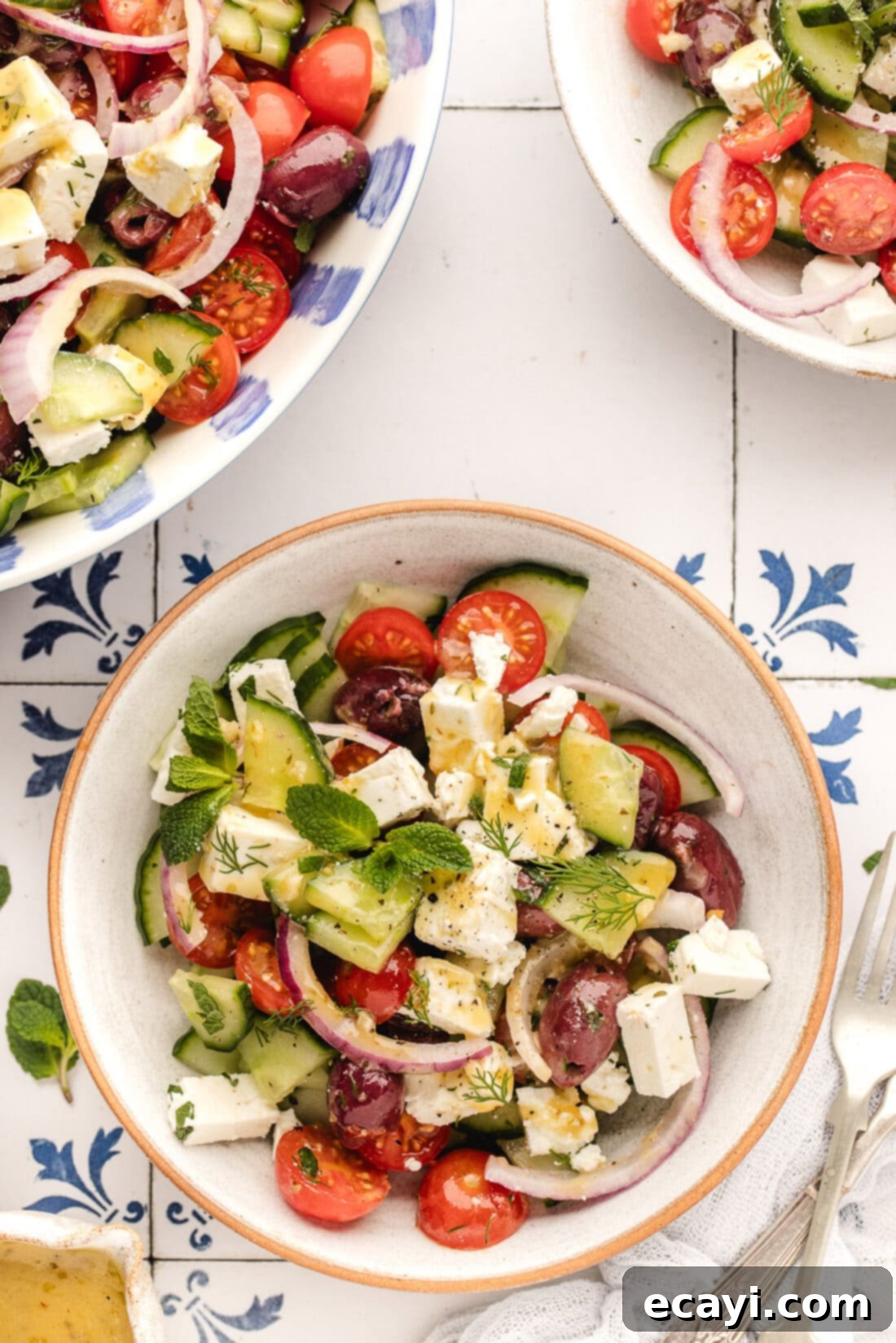
Serving Suggestions for Your Mediterranean Masterpiece
Greek salad is incredibly versatile and pairs beautifully with a wide array of dishes, making it suitable for almost any meal or occasion. Its light and refreshing profile makes it an ideal side dish to complement richer flavors. Consider pairing it with grilled salmon or succulent Greek chicken kabobs for a complete and healthy Mediterranean-inspired meal. It’s also fantastic alongside grilled lamb chops, lemon herb roasted chicken, or even simple pan-seared white fish. For a truly authentic experience, serve it as part of a larger mezze platter with warm pita bread, creamy hummus, baba ghanoush, and falafel. You can also enjoy it as a satisfying, light lunch on its own, perhaps with some crusty bread to soak up the delicious dressing. Always serve chilled for the best refreshing taste.
More Irresistible Summer Salad Recipes
If you’re anything like us, summer means an abundance of fresh, vibrant salads! If you loved this Greek salad, you’ll surely enjoy exploring some of our other favorite warm-weather recipes:
- Caprese Salad
- Cucumber Salad
- Spaghetti Salad
- Watermelon Salad
- Mediterranean Potato Salad
- Salmon Salad
I love to bake and cook and share my kitchen experience with all of you! Remembering to come back each day can be tough, that’s why I offer a convenient newsletter every time a new recipe posts. Simply subscribe and start receiving your free daily recipes!

Greek Salad
IMPORTANT – There are often Frequently Asked Questions within the blog post that you may find helpful. Simply scroll back up to read them!
Print It
Pin It
Rate It
Save It
Saved!
Prevent your screen from going dark
Course:
Salad, Side Dish
Cuisine:
Greek
4
servings
10 minutes
480
Amanda Davis
Ingredients
Salad
-
1 large English cucumber sliced into rounds and then quarters -
2 cups halved cherry tomatoes -
½ red onion finely sliced -
8 ounces feta cheese cubed -
1 cup kalamata olives -
1 small handful of dill roughly chopped -
1 small handful of mint roughly chopped
Dressing
-
½ cup extra virgin olive oil -
3 Tablespoons red wine vinegar -
2 teaspoons Dijon mustard -
½ lemon juiced -
1 clove garlic minced -
2 teaspoons dried oregano -
salt and pepper to taste
Things You’ll Need
-
Large Serving Bowl -
Chef’s knife -
Cutting board -
Mason jar with lid
Before You Begin
- This salad is incredibly adaptable. The quantities can easily be halved for a smaller serving or doubled (or even tripled) to feed a larger crowd, making it perfect for any occasion.
- For the best crisp texture and minimal sogginess, we recommend using an English cucumber. These have fewer watery seeds and a sweeter crunch than regular cucumbers, and their thin skin means no peeling required.
- You have flexibility with tomatoes! Use sweet cherry or grape tomatoes, or if you prefer, chop larger tomatoes like Roma or beefsteak into bite-sized pieces. Just ensure they are ripe and flavorful.
- The dressing is a fundamental classic Greek vinaigrette. To prepare, simply add all dressing ingredients to a mason jar with a secure lid and shake vigorously until well combined and emulsified.
- For optimal freshness, especially when preparing ahead, store the dressing separately from the salad ingredients. Toss the dressing into the salad just before serving to keep your vegetables crisp and vibrant.
Instructions
-
Chop all the salad ingredients: cucumber, tomatoes, red onion, feta, Kalamata olives, fresh dill, and mint. Place everything into a large serving bowl.
-
To prepare the dressing, combine all dressing ingredients (extra virgin olive oil, red wine vinegar, Dijon mustard, lemon juice, minced garlic, dried oregano, salt, and pepper) in a jar. Secure the lid tightly and shake vigorously until the mixture is fully combined and emulsified.
-
Just before serving, pour the prepared dressing over the chopped salad ingredients. Gently toss to combine everything evenly, ensuring all components are coated with the flavorful vinaigrette.
-
Serve immediately and enjoy your fresh, vibrant Greek Salad!
Expert Tips & FAQs
- For the best taste and texture, Greek Salad should ideally be dressed just before serving. Leftovers can be stored in an airtight container and refrigerated for up to two days, though the vegetables might soften slightly.
- The dressing can be made and stored separately in an airtight jar in the refrigerator for 4-5 days, making meal prep much easier.
- To mellow the sharpness of red onion, slice it thinly and soak it in cold water for 10-15 minutes before adding to the salad.
Nutrition
Serving:
1
serving
|
Calories:
480
cal
|
Carbohydrates:
13
g
|
Protein:
10
g
|
Fat:
45
g
|
Saturated Fat:
12
g
|
Polyunsaturated Fat:
4
g
|
Monounsaturated Fat:
26
g
|
Cholesterol:
50
mg
|
Sodium:
1213
mg
|
Potassium:
388
mg
|
Fiber:
3
g
|
Sugar:
4
g
|
Vitamin A:
867
IU
|
Vitamin C:
28
mg
|
Calcium:
345
mg
|
Iron:
2
mg
Tried this Recipe? Pin it for Later!
Follow on Pinterest @AmandasCookin or tag #AmandasCookin!
The recipes on this blog are tested with a conventional gas oven and gas stovetop. It’s important to note that some ovens, especially as they age, can cook and bake inconsistently. Using an inexpensive oven thermometer can assure you that your oven is truly heating to the proper temperature. If you use a toaster oven or countertop oven, please keep in mind that they may not distribute heat the same as a conventional full sized oven and you may need to adjust your cooking/baking times. In the case of recipes made with a pressure cooker, air fryer, slow cooker, or other appliance, a link to the appliances we use is listed within each respective recipe. For baking recipes where measurements are given by weight, please note that results may not be the same if cups are used instead, and we can’t guarantee success with that method.
